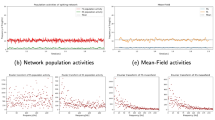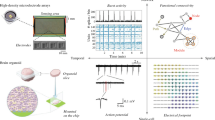Summary
In rats anaesthetized with urethane, push pull cannulae were stereotaxically introduced in the hippocampus (bilaterally) and Zn2+ assayed in the perfusate by atomic absorption spectrophotometry. When the cannula was located in the immediate vicinity of the mossy fiber zone, both spontaneous and K+ evoked release of Zn2+ were observed, this release was associated with a reduction in the histologically demonstrable Zn2+ as assessed by means of the Timm's stain. Neither spontaneous nor evoked release of Zn2+ was observed when the cannula was located in the medial part of CA1, the fimbria or the thalamus. These observations suggest that Zn2+ is released in the mossy fiber zone.
Similar content being viewed by others
References
Amaral DG, Dent JA (1981) Development of the mossy fibers of the dentate gyms. I. A light and electron microscopic study of the mossy fibers and their expansions. J Comp 195: 51–86
Assaf SY, Chung SH (1984) Release of endogenous Zn2+ from brain tissue during activity. Nature 308: 734–736
Ben-Ari Y (1985) Limbic seizure and brain damage produced by kainic acid: mechanisms and relevance to human temporal lobe epilepsy. Neuroscience Commentary — Vol 14 (in press)
Ben-Ari Y, Tremblay E, Ottersen OP (1980) Injections of kainic acid into the amygdaloid complex of the rat: an electrographic, clinical and histological study in relation to the pathology of epilepsy. Neuroscience 5: 515–528
Charrière B, Daudet F, Guibert B, Barberis C, Leviel V (1983) “In situ” release of dopamine in the nucleus amygdaloideus centralis. Brain Res 271: 386–387
Donaldson J, St-Pierre T, Minnich J, Barbeau A (1971) Seizures in rats associated with divalent cation inhibition of Na±K+ATPase. Can J Biochem 48: 1217–1224
Frederickson CJ, Howell GA, Kasarkis EJ (eds) (1984) The neurobiology of zinc, Part A: Physiochemistry, anatomy and techniques. Alan R Liss, New York, 390 pp
Frederickson CJ, Klitemick MA, Manton WI, Kirkpatrick JB (1983) Cytoarchitectonic distribution of zinc in the hippocampus of man and the rat. Brain Res 273: 335–339
Haug FMS (1967) Electron microscopical localization of the zinc in hippocampal mossy fiber synapses by a modified sulphide silver procedure. Histochemie 8: 355–368
Haug FMS (1973) Heavy metals in the brain. A light microscopic study of the rat with Timm's sulphide silver method. Methodological considerations and cytological and regional staining patterns. Adv Anat Embryol Cell Biol 47: 1–71
Howell GA, Welch MG, Frederickson CJ (1984) Stimulation induced uptake and release of zinc in hippocampal slices. Nature 308: 736–738
Lorente de Nó R (1934) Studies on the structure of the cerebral cortex continuation of the study of the ammon's system. J Psych Neurol (Leipzig) 46: 113–177
Margerison JH, Corsellis YAN (1966) Epilepsy and the temporal lobes. A clinical, electroencephalographic and neuropathologic study of the brain in epilepsy with particular reference to the temporal lobes. Brain 89: 499–530
Nadler JV, Cuthberson GJ (1980) Kainic acid neurotoxicity toward hippocampal formation: dependence on specific excitatory pathways. Brain Res 195: 47–56
Nadler JV, Perry BW, Gentry C, Cotman CW (1980) Degeneration of hippocampal CA3 pyramidal cells induced by intraventricular kainic acid. J Comp Neurol 192: 333–359
Pinard E, Ben-Ari Y, Tremblay E, Seylaz J (1983) Is intratissular hypoxia responsible for lesions during seizures induced by kainic acid? In: Baldy-Moulinier M (ed) Cerebral blood flow, metabolism and epilepsy. J Libbey, London, pp 252–257
Sloviter RS (1983a) A simplified Timm stain procedure compatible with formaldehyde fixation and routine paraffin embedding of rat brain. Brain Res 8: 771–774
Sloviter RS (1983b) Epileptic brain damage in rats induced by sustained electrical stimulation of the perforant path. I. Acute electrophysiological and light microscopic studies. Brain Res Bull 10: 675–698
Sloviter RS (1984) A selective loss of Timm staining in the hippocampal mossy fiber pathway accompanies electrically induced hippocampal granule cell seizure activity in rats. In: Frederickson CJ, Howell GA, Kasarkis EJ (eds) The neurobiology of zinc, Part A: Physiochemistry, anatomy and techniques. Alan R Liss, New York, pp 127–140
Spielmeyer W (1927) Die Pathogenesis des epileptischen Krampfes. Z Neurol Psychiat 109: 501–520
Swanson LW, Wyss JM, Cowan WM (1978) An antoradiographic study of the organization of intra hippocampal association pathways in the rat. J Comp Neurol 181: 681–716
Von Euler C (1962) On the significance of the high zinc content in the hippocampal formation. In: Physiologie de l'hippocampe. Colloques internationaux du C.N.R.S. — C.N.R.S., Paris, pp 135–143
Author information
Authors and Affiliations
Rights and permissions
About this article
Cite this article
Charton, G., Rovira, C., Ben-Ari, Y. et al. Spontaneous and evoked release of endogenous Zn2+ in the hippocampal mossy fiber zone of the rat in situ. Exp Brain Res 58, 202–205 (1985). https://doi.org/10.1007/BF00238969
Received:
Accepted:
Issue Date:
DOI: https://doi.org/10.1007/BF00238969




